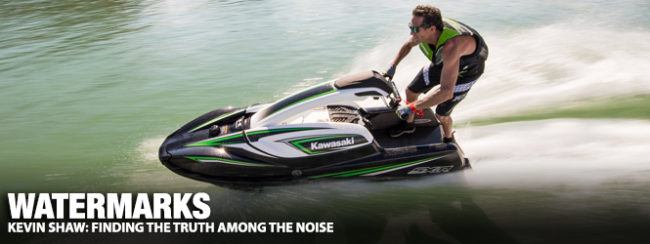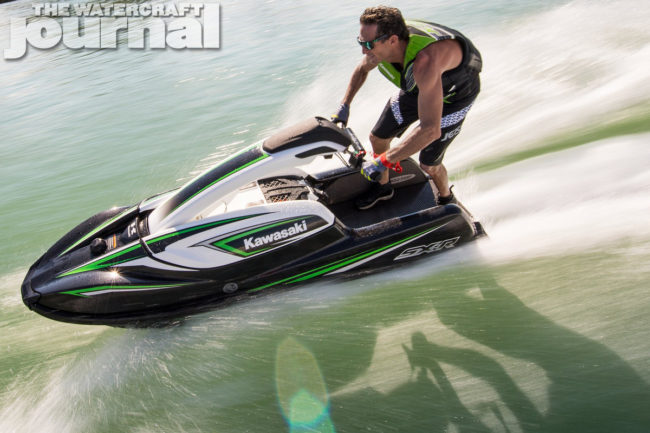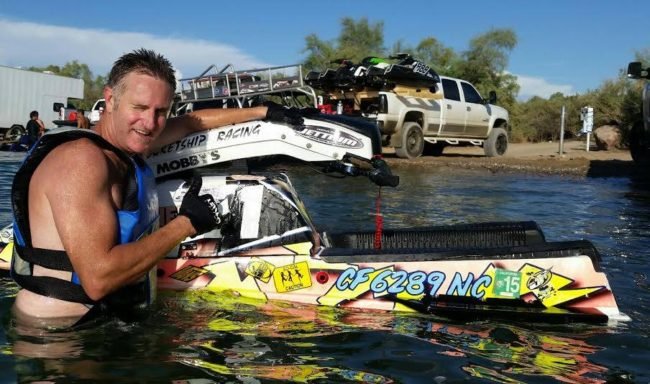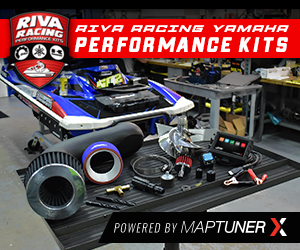
“There’s a lot riding on it,” a friend cautioned over the phone. “They’re worried about what’s being said about it.” The “they” in this conversation was Kawasaki, and the “it” was the new 1,498cc 4-stroke, 160-horsepower SX-R. Since its release to the general public over a month ago, a purported 900 units have been shipped to the fulfill the existing 2,400 units requested by dealers. Earlier this month, nine SX-Rs participated in the annual Mark Hahn Memorial (ie. Havasu 300); and to date, the SX-R has graced the covers and filled the pages of Japanese and European publications as domestic PWC and boating magazines await an overdue press introduction, scheduled for this coming April. Thus far, public opinions have been predominantly good with several vocalizing the potential impact the coming SX-R will have on the racing landscape. “Remember when the [800] came out – what? Like 15 years ago? Everyone with a 750 thought the SX-R was a pig. Now look at it,” my friend continued. “Everybody wants one. It’s the standard for racing. That’s what this thing is going to do.”
At first blush, the 8-foot, 7-inch length, and 551-pound heft of the 2017 SX-R is a lot to take in. For some, it’s too much altogether. “It’s a standabout!” commenters have howled in forums and on social media. But the truth is often quietly found below the din of so many opinions. To date, all radar and GPS records have the new JetSki reaching slightly over 62 miles per hour in showroom stock trim. These speeds were only achieved by race fuel-fed triples and turbocharged Hydros previously. Equally, the unusually tiered nose (featuring splash deflectors) and deep channels running along the strakes adds to the claims that much of the SX-R’s design DNA is culled from the STX-15F – not to mention almost the entirety of its powertrain. When questioned, the answer was clarion clear: “Because it was designed for those big, stupid IJSBA race courses. That’s why.” The tight, complex buoy course that elevated Jeff Jacobs, Chris Fischetti, and Larry Rippenkroeger to stardom have ballooned in the decades following their tenure, replacing complicated, technical courses with long straightaways, sweeping turns and the like.
Above: From its earliest beginnings, the Kawasaki JetSki existed to own a segment, to stand solitary on a precipice unoccupied and or wholly unchallenged.

Above: The progression of the Kawasaki JetSki continued as a response to the innovations of pioneering tuners and the boundaries pushed by racers such as Chris “The Flyin’ Fish” Fischetti.
Evolution within a specific sport is commonplace. From its earliest years in the Harvard Yard to the gridiron of today’s NFL, the equipment, padding, footwear and in-field communication equipment of today’s professional football players dwarfs that of thick, woolen sweaters, cotton trousers and Naugahyde-stitched leather caps of a century earlier. So to have gone the rough-hewn fiberglass hulls, and two-cylinder 2-strokes that filled the starting lines of the Budweiser IJSBA National Tour nearly 30 years ago. That progress doesn’t diminish the achievements or talents of those racers, builders and tuners; rather we owe today’s superior machines to them in large degree. The Christy Carlsons, Dave Gordons, Victor Sheldons, Scott Watkins, and Bill Chapins of the 1980s and 1990s gave us what we have (and often take for granted) today.
Certainly aftermarket hulls from skilled designers (ie. ProForce, Bullett, Trinity, etc.) have taken from existing designs and magnified their abilities to ride on the rail nearly perpendicularly to the water, their pumps remaining engaged, the rider articulated in such a precarious position that a snapshot taken mid-turn looks like a balance of chaos and ballet. By many accounts reporting in, the SX-R neither requires such acrobatics nor responds to such drastic rider inputs. Overshadowed by its power output and sheer size, the truly remarkable talent of the new 2017 JetSki SX-R very well may be its ability to preserve the rider during dire conditions. The SX-R is slowly revealing itself as the potential champion of offshore surf races, brutally wind-chopped lakes and the churning turmoil of a multi-lap race course. Mike Klippenstein who competed in three classes simultaneously at this year’s Mark Hahn Memorial (two runabout, one standup), praised the SX-R for tackling 20-30 mph wind-whipped seas, the standup actually surpassing several runabouts in the chop.
Above: The records of the sport’s biggest names in racing might have already been eclipsed, but their accomplishments remain ever as important. Persons such as Jeff Jacobs and the aforementioned Fischetti, among many, many others have raised the bar significantly.

Above: Today, modern standup racing takes many forms, many of which are both distant and not so far removed from decades earlier. The new Kawasaki SX-R aims to reclaim its class dominance in this segment by offering superior power, added stability and less wear on the rider – particularly in rough conditions.
“This isn’t the same 550 that you and I grew up on,” the voice on the other end of the line continued. “It’s not the ski you threw into the bed of your pickup, drove down to the lake, chucked out a couple buoys and ripped around on.” Rather, the JetSki that Kawasaki is rolling out is purpose-built for race class dominance. “It’s almost unfair. It’s gonna kill those guys on triples, or who have finally sunk all their money into a Hydro. You’re gonna hear a lot of crying,” he added. The thought was maddening, but relatable. It has been a very long time since a manufacturer produced a product so perfectly designed for class dominance that its introduction immediately antiquates the competition. It’s as exciting as it is frustrating – yet, the process is nothing new. The earliest decades of this sport were strictly Kawasaki territory. Even Yamaha’s early SuperJets (first introduced in 1989) took a while to earn their place on the podium. From there, the race was neck-and-neck, with various models of ski being introduced in an effort to lock in a class or out-do the other.
Certainly, the new SX-R will appeal to the civilian jet ski enthusiasts, those who wish to enjoy the thrill of standup jet skiing in lakes and bodies of water where two-strokes have since been outlawed. Equally, as given early reports of the SX-R’s characteristics, older or slightly less athletic riders will enjoy its buoyed stability and the even temperament of the digitally-fuel injected 4-stroke. Yet, the goal is singular: complete and total dominance of a category that Kawasaki has long since been absent. It’s been told that the development of the new SX-R was fueled strictly by passion, passion on behalf of Minoru Kanamori and Craig “Fuzzy” Boyd. That it was birthed during early morning testing sessions and late-in-to-the-evening wrenching hours. That it exists because of sure willpower, not because it made sense on paper or was a market segment needing to be filled. For that, much needs to be said but hasn’t. Rather, in keeping with Kanamori’s humility, he’s let the SX-R slowly speak for itself. And as the weeks and months proceed, and the Kawasakis continue to fill podiums, we’re going to know assuredly what this machine was bred to do. And that is why it needed to be built.
Go Get Wet,
Kevin
[I realize this is the second editorial in a single month, so for that I apologize. The advent of the new SX-R has been consuming my thoughts for months now – to the point of madness – and felt it necessary to expound. – Ed.]













Great article. So true…
No Power Sports Manufacturer builds something to finish second on the race course…It appears the new SXR will be successful on the race course and I hope it continues to help the brand sell more units as a whole. This SXR could be what the Dodge “Hellcat Twins” did for that brand; increase sales through excitement of a halo model…only time will tell 🙂
All this time I cannot remember any “air cooled two cylinder two stroke” in any Kawasaki Jet ski racing in the early 80’s on the Budweiser Tour.
I only hope that Kawasaki takes this ski and builds a GEN 3 X2!
Excuse the foolish typo on the 2-strokes, but Bud Tour we speak of is the early 1990s.
I can’t say I have much time on my new boat
I can say it pulls like a frieght train
It seems very responsive I’m not a fan of the throttle Or the bars
You don’t feel the weight The ass end seemed very well planted It didn’t want to slide out it stayed hooked up
You can go further and farther Then I ever thought about taking my old sxr the weight makes it more stable
A fat mans stand up on steroids One time riding my old SX R I was flying across the water and I grabbed the bars to see how fast I could turn I ended up pulling a muscle in my leg It hurt like hell My Jetski buddy mechanic said you’ll be thinking about next time you grab the bars like that
I don’t think the new sxr is responsive as the old one It’s definitely harder to handle with the weight
On land but I love it Now I have to figure out if I can keep my promise to my other half
I’m gonna sell my 800 if I get the new ski. But the case remains open
I’m thinking that I’m gonna keep both but I do feel bad for all the guys that have spent stupid money to go fast or want to get top dollar for old stand ups Like I’m gonna pay $9000 for a 1100 SX R
kawasaki will always be the king of the standups These boats were made for racing
Kevin
This article is extremely well written and really illustrates the purpose of the new SXR.
I’m still a big fan of my Superjet and I’m building a Trinity as I love the athletic work out and quick turning handling.
When Yamaha makes a TR-1 based light stand up maybe then will I go to a four stroke model.
[…] little left out. Yes, the build up leading to the new 2017 SX-R reveal was some pretty big news and shined a favorable light on the brand. But that’s really been it – that is, since the 2014 refresh of the Ultra 1498cc powerplant, […]